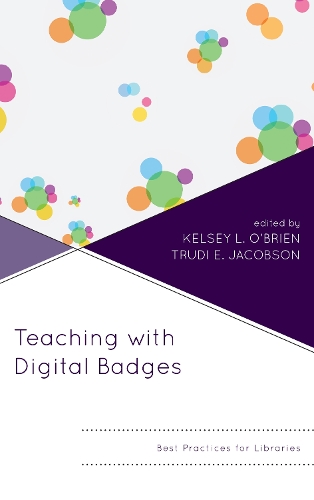
Teaching with Digital Badges: Best Practices for Libraries
(Paperback)
Available Formats
Publishing Details
Teaching with Digital Badges: Best Practices for Libraries
By (Author) Kelsey O'Brien
Edited by Trudi E. Jacobson
Bloomsbury Publishing PLC
Rowman & Littlefield Publishers
15th September 2018
United States
Classifications
Professional and Scholarly
Non Fiction
025
Physical Properties
Paperback
246
Width 152mm, Height 221mm, Spine 18mm
503g
Description
Digital Badges are gaining traction in the education landscape, and librarians have been some of the leading pioneers at the forefront of this exciting new frontier. This book provides examples of how badges are being used to enhance and invigorate the teaching and assessment of information literacy. Chapters provide inspiration for teaching librarians interested in: Providing an engaging experience for their students Gaining insight into this growing innovative technology trend Discovering how librarians are using badges to enhance their teaching Forming meaningful collaborations with faculty and teachers Developing knowledge about badge system design and badging platforms Learning how badges can motivate, support, and celebrate learning achievements Launching a badging project The book is divided into two sections. The first section explores the environment in which badges are being developed, in particular situating them within the current educational setting, and provides guidelines on how best to create a badging program. The second section details contributing authors firsthand experiences creating, implementing, and refining digital badges and digital badging systems, in some cases collaborating with teachers and faculty. These chapters provide a wealth of ideas about using digital badges in academic and school libraries to engage and motivate students.
Reviews
This is an excellent resource forlibrarycommunities. It provides great ideasfor those who want to start a badging program. For those who have started,the case studies and research help to bolster and round out our experiences. -- Emily Rimland, Penn State University Libraries
A book from the trenches by authors implementing badges into complex settings. Whether readers are just starting their journey with badges or are experienced practitioners looking for new ideas, this book has something for everyone. -- Lucas Blair, Co-founder Little Bird Games
Digital badges are a natural fit for libraries and information literacy skills, but implementation still needs design principles that fit with the project goals and stakeholder needs. The perspectives, recommendations, and informative case studies in this book show digital badges' potential as connectors and guide implementers to important considerations. -- Nate Otto, Co-Author of the Open Badges Specification & Director, Badgr
Author Bio
Kelsey O'Brien is an Information Literacy Librarian at the University at Albany, SUNY. She has been involved with digital badges for the past several years, beginning in 2013 when she first started working on the Metaliteracy Badging System. Since then she has played a central role in its design and implementation, and enthusiastically follows the latest badge-related literature and trends. Kelsey is incoming co-convener of ACRL's Digital Badges Interest Group and an active member of SUNY's FACT2 Micro-credentialing Task Force. She has presented extensively on badges at her home institution and at national (ALA, LOEX) and international conferences (LILAC), and has also co-taught two metaliteracy MOOCs, one of which incorporated digital badges. Prior to her role as an academic librarian, Kelsey has worked as a high school Library Media Specialist and a Youth Services Librarian. She serves as the liaison for the Writing and Critical Inquiry program at the University at Albany, a required course for first year students, and enjoys helping students transition from high school to college research. Kelsey can be contacted at klobrien@albany.edu or via Twitter at @KelseyMoak. Trudi Jacobson is the Head of the Information Literacy Department at the University at Albany, and holds the rank of Distinguished Librarian. She has been deeply involved with information literacy throughout her career, and thrives on finding new and engaging ways to teach students, both within courses and through less formal means. She has worked closely with Thomas Mackey for many years. Together, they originated the metaliteracy framework to emphasize the metacognitive learner as producer and participant in dynamic information environments. They co-authored the first article to define this model with Reframing Information Literacy as a Metaliteracy (C & RL, 2011) and followed that piece with their book Metaliteracy: Reinventing Information Literacy to Empower Learners (Neal-Schuman, 2014). They co-authored the essay Proposing a Metaliteracy Model to Redefine Information Literacy (2013) and co-edited their most recent book for ALA/Neal-Schuman entitled Metaliteracy in Practice (2016). She has also written extensively on other topics. She co-chaired the Association of College & Research Libraries Task Force that created the Information Literacy Framework for Higher Education. Trudi is a member of the Editorial Board of Communications in Information Literacy. She freelances as the acquisitions editor for Rowman & Littlefields Innovations in Information Literacy series. Trudi was the 2009 recipient of the Miriam Dudley Instruction Librarian Award. You can contact her at tjacobson@albany.edu
